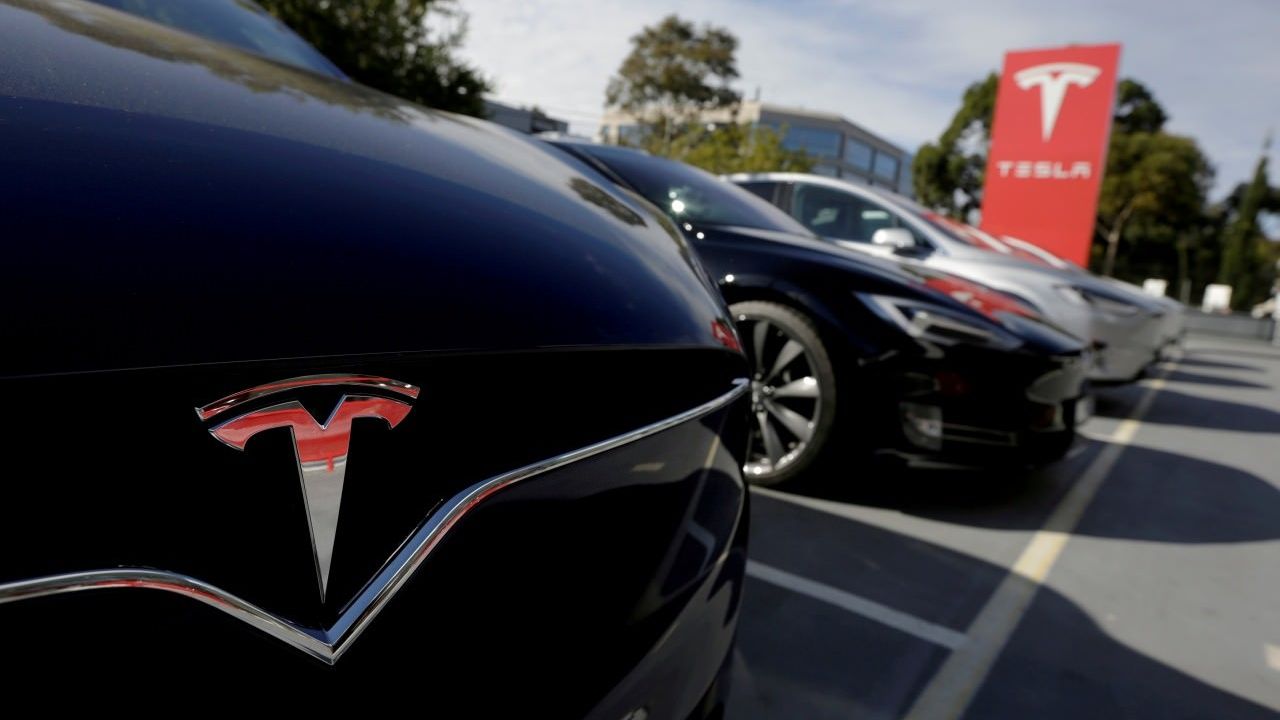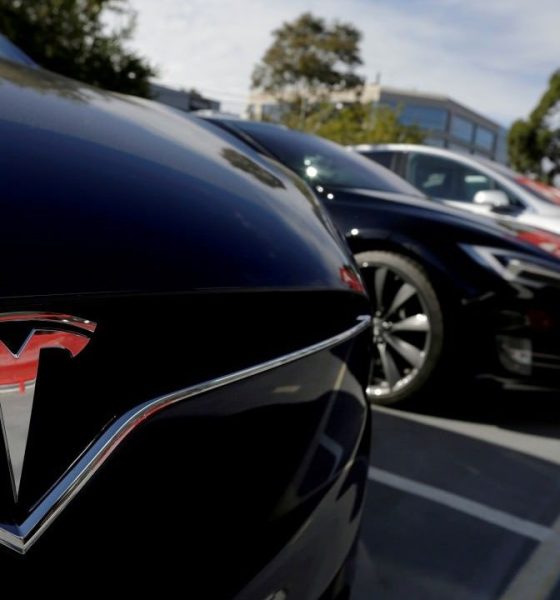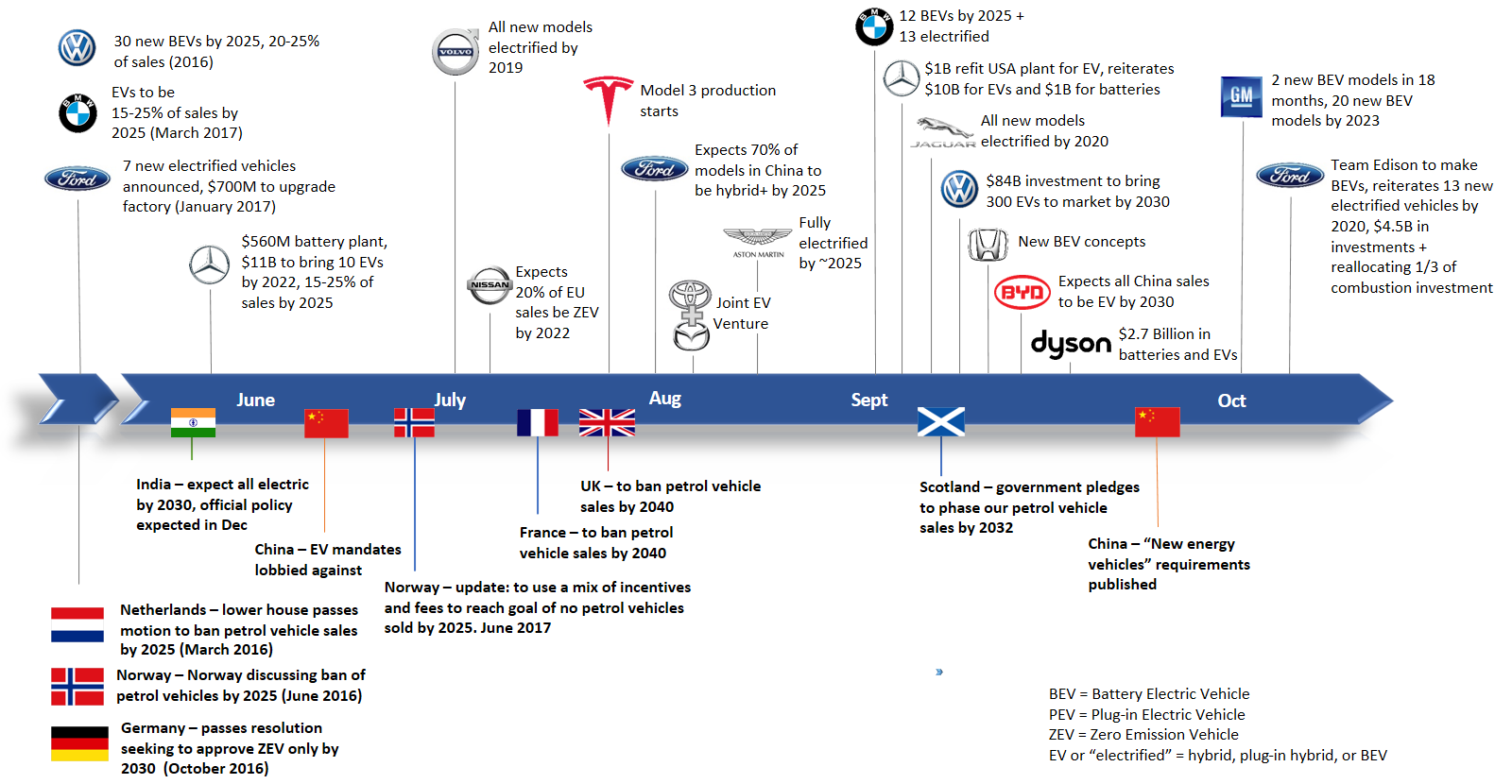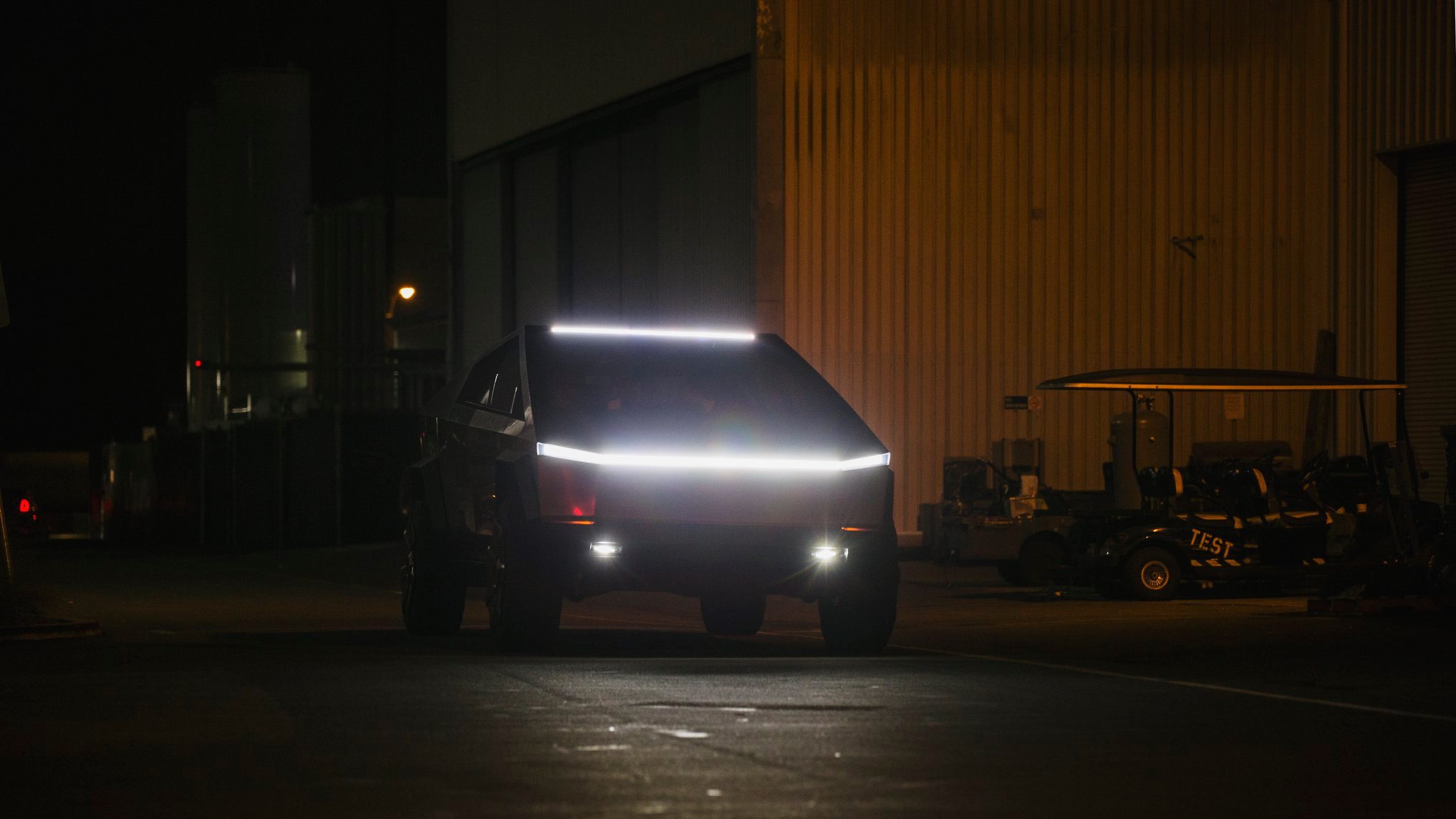

News
Tesla ushers in the age of EVs and the demise of the gas-guzzler
This year could start the beginning of the end for the internal combustion engine. Heck, The Economist gave the internal combustion engine an obituary this year in a recent cover story. And, according to Peter Holley at the Washington Post, “when future auto historians look back, they may pinpoint 2017 as the year electric vehicles went from a promising progressive fad to an industry-wide inevitability.”
Holley points out a number of signposts surfacing this year that pose a threat to the diesel and gas-powered automobile. The internal combustion engine (ICE) may be on… ummm, thin ice. So, as we look at the events unfolding this year, what indictors are contributing to this tectonic shift in the auto sector?
1. Tesla Model 3 ushers in the age of electric vehicles
Of course at the top of our list is the “the debut of Tesla’s Model 3” this year. Holley writes, “The company’s first mass-market vehicle has ushered in an era of excitement about EVs because of the car’s slick design and starting price of around $35,000.” But don’t let that lower price point fool you, Tesla is poised to achieve healthy margins for the Model 3 too.
2. China is going electric
China has proved a massive market opportunity for Tesla. And CEO Elon Musk may soon be announcing a Tesla factory in Shanghai. China’s also the world leader in electric vehicle sales by a wide margin. It’s reported that, “in addition to setting aggressive production quotas for EVs, China plans to scrap internal combustion engines entirely as soon as 2030. By taking a lead role in the shift to plug-ins, the world’s largest auto market is forcing the rest of the international community to follow in its footsteps.” And, other countries are following China’s lead.
Above: China takes the lead in electric vehicles (Youtube: Wall Street Journal)
3. Gas stations are installing electric vehicle chargers
Gas stations have been taking some unlikely cues from Tesla. And, “some experts believe electric cars have sounded the death knell of the American gas station.” John Abbott, Shell Oil’s business director admits, “We’re looking at having battery charging facilities.” This past week Shell signed an agreement to buy the electric vehicle charging company, NewMotion, which, “operates more than 30,000 private electric charge points for homes and businesses in the Netherlands, Germany, France and the U.K.”
4. Auto mechanics have less work to do
Electric cars require far less maintenance than gas-powered cars. “One of the primary reasons that auto owners visit a mechanic is for an oil change, which raises a question: What happens when vehicles no longer rely on oil? It’s not that electric vehicles won’t require maintenance (they still have brakes, tires and windshield wipers, after all), but their engines are far simpler, experts say.” Tony Seba, a clean energy expert, notes that electric vehicles, “have 20 moving parts, as opposed to 2,000 in the internal combustion engine… [and] are far cheaper to maintain.”
5. Big Auto announces electrifying plans
Jessica Caldwell, analyst at Edmunds admits, “You really do feel like this electrification thing is suddenly very real… There’s a momentum we haven’t really seen before. It’s coming from other countries around the world and from big automakers, and that’s forcing everyone else to comply.” Although, to be fair, it’s conceivable some of Big Auto’s EV announcements could just be feel-good window dressing for their brands. After all, legacy automakers are using some crafty wordplay hyping electrified cars instead of all-electric cars.

Above: Announcements from automakers (and countries) committing themselves to an electric vehicle future (Image: Teslarati)
6. Environmental impact of fossil fuel powered cars
With tales of cartels and collusion surrounding Germany’s dirty diesel programs, public perception is starting to shift. And the research is conclusive, electric vehicles are cleaner. Gina Coplon-Newfield, Director of Sierra Club’s Electric Vehicles Initiative explains, “Depending on how electricity is produced in your region, plug-ins are from 30 percent to 80 percent lower in greenhouse gas emissions.” She notes if companies like GM step up with plans to launch EV fleets, reductions in carbon emissions and improvements in air quality could be “hugely beneficial.”
===
Note: Article originally published on evannex.com, by Matt Pressman
Source: Washington Post

News
Tesla launches its new branded Supercharger for Business with first active station

Tesla has officially launched its first branded Supercharger just months after initiating a new program that allows third-party companies to brand their own charging piles.
The site opened in Land O’ Lakes, Florida, and features eight V4 Supercharging stalls offering up to 325 kW of charging speed. It appears it was purchased by a company called Suncoast Credit Union. This particular branch is located Northeast of Tampa, which is on the Gulf of Mexico.
It features graphics of Florida animals, like alligators:
Here’s a video of the graphics being installed on the Tesla Superchargers at this site: https://t.co/oIfEPNZjAH pic.twitter.com/ENWakZ2qT9
— TESLARATI (@Teslarati) November 20, 2025
Tesla launched this program back in September, and it basically was a way to expand its Supercharger presence and also allow companies to pay for the infrastructure. Tesla maintains it. When it announced the “Supercharger for Business,” it said:
“Purchase and install Superchargers at your business. Superchargers are compatible with all electric vehicles, bringing EV drivers to your business by offering convenient, reliable charging.”
The program does a few things. Initially, it expands EV charging infrastructure and makes charging solutions more readily available for drivers. It can also attract people to those businesses specifically.
Tesla launches new Supercharger program that business owners will love
The chargers can also be branded with any logo that the business chooses, which makes them more personalized and also acts as an advertisement.
The best part is that the customers do not have to maintain anything about the Supercharger. Tesla still takes care of it and resolves any issues:
“We treat your site like we treat our sites. By providing you with a full-service package that includes network operations, preventative maintenance, and driver support, we’re able to guarantee 97% uptime–the highest in the industry.”
It appears the Superchargers will also appear within the in-car nav during routing, so they’ll be publicly available to anyone who needs to use them. They are still available to all EVs that have worked with Tesla to utilize its infrastructure, and they are not restricted to people who are only visiting the business.
Cybertruck
Tesla reveals its Cybertruck light bar installation fix

Tesla has revealed its Cybertruck light bar installation fix after a recall exposed a serious issue with the accessory.
Tesla and the National Highway Traffic Safety Administration (NHTSA) initiated a recall of 6,197 Cybertrucks back in October to resolve an issue with the Cybertruck light bar accessory. It was an issue with the adhesive that was provided by a Romanian company called Hella Romania S.R.L.
Tesla recalls 6,197 Cybertrucks for light bar adhesive issue
The issue was with the primer quality, as the recall report from the NHTSA had stated the light bar had “inadvertently attached to the windshield using the incorrect surface primer.”
Instead of trying to adhere the light bar to the Cybertruck with an adhesive, Tesla is now going to attach it with a bracketing system, which will physically mount it to the vehicle instead of relying on adhesive strips or glue.
Tesla outlines this in its new Service Bulletin, labeled SB-25-90-001, (spotted by Not a Tesla App) where it shows the light bar will be remounted more securely:


The entire process will take a few hours, but it can be completed by the Mobile Service techs, so if you have a Cybertruck that needs a light bar adjustment, it can be done without taking the vehicle to the Service Center for repair.
However, the repair will only happen if there is no delamination or damage present; then Tesla could “retrofit the service-installed optional off-road light bar accessory with a positive mechanical attachment.”
The company said it would repair the light bar at no charge to customers. The light bar issue was one that did not result in any accidents or injuries, according to the NHTSA’s report.
This was the third recall on Cybertruck this year, as one was highlighted in March for exterior trim panels detaching during operation. Another had to do with front parking lights being too bright, which was fixed with an Over-the-Air update last month.
News
Tesla is already expanding its Rental program aggressively
The program has already launched in a handful of locations, specifically, it has been confined to California for now. However, it does not seem like Tesla has any interest in keeping it restricted to the Golden State.

Tesla is looking to expand its Rental Program aggressively, just weeks after the program was first spotted on its Careers website.
Earlier this month, we reported on Tesla’s intention to launch a crazy new Rental program with cheap daily rates, which would give people in various locations the opportunity to borrow a vehicle in the company’s lineup with some outrageous perks.
Along with the cheap rates that start at about $60 per day, Tesla also provides free Full Self-Driving operation and free Supercharging for the duration of the rental. There are also no limits on mileage or charging, but the terms do not allow the renter to leave the state from which they are renting.
🚨🚨 If you look up details on the Tesla Rental program on Google, you’ll see a bunch of sites saying it’s because of decreasing demand 🤣 pic.twitter.com/WlSQrDJhMg
— TESLARATI (@Teslarati) November 10, 2025
The program has already launched in a handful of locations, specifically, it has been confined to California for now. However, it does not seem like Tesla has any interest in keeping it restricted to the Golden State.
Job postings from Tesla now show it is planning to launch the Rental program in at least three new states: Texas, Tennessee, and Massachusetts.
The jobs specifically are listed as a Rental Readiness Specialist, which lists the following job description:
“The Tesla Rental Program is looking for a Rental Readiness Specialist to work on one of the most progressive vehicle brands in the world. The Rental Readiness Specialist is a key contributor to the Tesla experience by coordinating the receipt of incoming new and used vehicle inventory. This position is responsible for fleet/lot management, movement of vehicles, vehicle readiness, rental invoicing, and customer hand-off. Candidates must have a high level of accountability, and personal satisfaction in doing a great job.”
It also says that those who take the position will have to charge and clean the cars, work with clients on scheduling pickups and drop-offs, and prepare the paperwork necessary to initiate the rental.
The establishment of a Rental program is big for Tesla because it not only gives people the opportunity to experience the vehicles, but it is also a new way to rent a car.
Just as the Tesla purchasing process is more streamlined and more efficient than the traditional car-buying experience, it seems this could be less painful and a new way to borrow a car for a trip instead of using your own.








